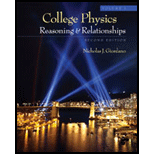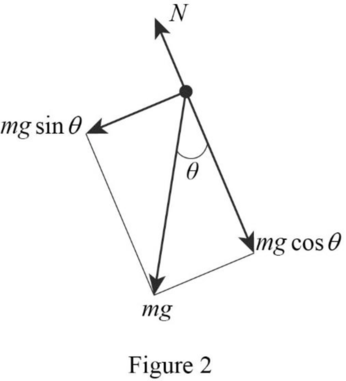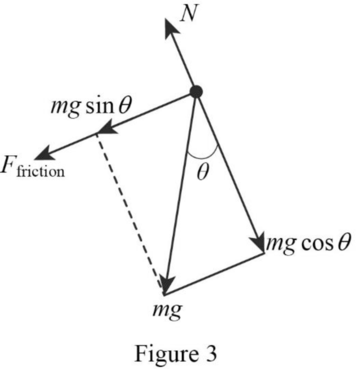
Concept explainers
(a)
The initial speed of the block.
(a)
Answer to Problem 83P
The initial speed of the block is
Explanation of Solution
Figure 1 represents that a block slides up a frictionless inclined plane.

From the above figure
Figure 2 represent the free body diagram of the block ignoring friction.

Write the expression for net force acting on the block in the
The above equation can be written as
Write the expression for net force acting on the block in the
The above equation can be written as
Write the kinematic equation.
Here,
Since the final velocity of the block is zero and the initial position of the block is zero, the above equation is written as
Use equation (I) and (II) in the above equation.
Conclusion:
Substitute
Therefore, the initial speed of the block is
(b)
The initial speed required for the block to reach the maximum height.
(b)
Answer to Problem 83P
The initial speed required for the block to reach the maximum height is
Explanation of Solution
Figure 3 represent the free body diagram of the block by considering friction.

Write the expression for net force acting on the block in the
The above equation can be written as
Write the expression for frictional force.
Here,
Use the above equation in equation (IV).
Write the kinematic equation.
Here,
Since the final velocity of the block is zero and the initial position of the block is zero, the above equation is written as
Use
Conclusion:
Substitute
Substitute
Therefore, the initial speed required for the block to reach the maximum height is
Want to see more full solutions like this?
Chapter 4 Solutions
College Physics, Volume 1
- A 12 kg box is released from the top of an incline that is 5 m long and makes an angle of 40 degrees to the horizontal. The friction force between the box and the incline is 60 N. What is the coecient of kinetic friction µk between the box and the incline?arrow_forwardA small block sits at one end of a flat board that is 4.00 m long. The coefficients of friction between the block and the board are μs= 0.450 and μ = 0.400. The end of the board where the block sits is slowly raised until the angle the board makes with the horizontal is α0, and then the block starts to slide down the board. If the angle is kept equal to α0 as the block slides, what is the speed of the block when it reaches the bottom of the board? Express your answer with the appropriate units.arrow_forwardOne non-powered sled is sliding over a snowed surface, first down from the top of a flat and inclined plane using only gravity and no initial speed and then it continues to move along a horizontal surface until a full stop. The plane’s surface is inclined with 45 degrees relative to the horizontal. The top of the inclined plane is 2 meters high relative to the same horizontal surface. The friction coefficient between the sled and snow is 0.05 on all surfaces. Determine the formula and the value for the distance made by the sled onto the horizontal surface.arrow_forward
- A 2.0 kg piece of wood slides on a curved surface . The sides of the surface are perfectly smooth, but the rough horizontal bottom is 30 m long and has a kinetic friction coefficient of 0.20 with the wood. The piece of wood starts from rest 4.0 m above the rough bottom. (a) Where will this wood eventually come to rest? (b) For the motion from the initial release until the piece of wood comes to rest, what is the total amount of work done by friction?arrow_forwardA 25 N block starts from rest and slide 9 m down a roof with a slope of 2 horizontal to 1 vertical and a coefficient of friction of 0.10. If the vertical distance from the edge of the roof to the ground is 12 m, what is the distance from the wall that the ball will strike the ground?arrow_forwardA 1500 kg car starts from rest at the top of the driveway that is sloped at an angle of 30 degrees to the horizontal. An average friction force of 3500 N impedes the car’s motion so that car’s speed at the bottom of the driveway is 4.2 m/s. What is the length of the driveway?arrow_forward
- Alaya designs a slide for sacks of rice to slide down, dropping from the first floor to ground level in a barn. The length of her slide is 8.5m along with an angle theta of 40 degrees from the horizontal. The coefficient of kinetic friction between the slide's surface is ?k=0.40 and the slide is not frictionless. At the top of slide, the sack slides down. The sack was initially at rest. After the sack leaves from the edge, it hits the ground z = 3.6m from the end of the slide a) Sketch the diagram b) determine the height from the top end point of the slide to the ground.arrow_forwardIn a "crazy elevator ride" at the amusement park, a 300 kg "elevator car" slides vertically down a frictionless shaft and curves onto a horizontal section, descending a total height of 25 m. On the horizontal section is a friction pad designed to bring the car to rest. If the coefficient of friction between the car and the pad is μk=0.4, how long in meters does the pad need to be to stop the car?arrow_forwardA skier starts from rest at the top of a hill that is inclined at 9.7° with respect to the horizontal. The hillside is 195 m long, and the coefficient of friction between snow and skis is 0.0750. At the bottom of the hill, the snow is level and the coefficient of friction is unchanged. How far does the skier glide along the horizontal portion of the snow before coming to rest?arrow_forward
- A 19.0 kg box is placed at the top of an inclined plane and released to either move freely or sit at rest. The plane is at an angle of 30° above the ground and has a total length of d = 2.80 m along the incline. The coefficient of static friction between the box and the plane is us = 0.40 and the coefficient of kinetic friction is pk = 0.30. What kind of friction does the box experience once it is released, and what is its magnitude? m d Kinetic, Fkf - 55.9 N Static, Fsf = 74.5 N Static, Fsf = 64.5 N Kinetic, Fkf = 48.4 Narrow_forwardA box with with a mass m = 2kg is being pushed up a ramp by an unknown pushing force Fp. The coefficient of static friction between the box and interface is 0.7. The coefficient of kinetic friction between the box and interface is 0.6. The incline of the ramp is 15 degrees. The velocity of the box is constant. The surface of the ramp is 12 m. Fp is removed when the box reaches the top of the ramp. What is the acceleratin of the box after Fp is removed?arrow_forwardA block is set into motion up an inclined plane (30° ) with an initial speed of 8.0 m/s. There is friction between the block ant the plane. The block comes to rest after traveling 4.8 m along the plane. V =8 m/s What is the value of the coefficient of friction u? HINT: remember that the friction force is given by f = µN = µ = N thus because both f and the N are proportional to the mass of the block m, m cancels out and you don't need it to find u. Thus you wont be able to find a value for f or N alone, so find your acceleration first, then an equation for u that is independent of m.arrow_forward
 Glencoe Physics: Principles and Problems, Student...PhysicsISBN:9780078807213Author:Paul W. ZitzewitzPublisher:Glencoe/McGraw-Hill
Glencoe Physics: Principles and Problems, Student...PhysicsISBN:9780078807213Author:Paul W. ZitzewitzPublisher:Glencoe/McGraw-Hill Principles of Physics: A Calculus-Based TextPhysicsISBN:9781133104261Author:Raymond A. Serway, John W. JewettPublisher:Cengage Learning
Principles of Physics: A Calculus-Based TextPhysicsISBN:9781133104261Author:Raymond A. Serway, John W. JewettPublisher:Cengage Learning

